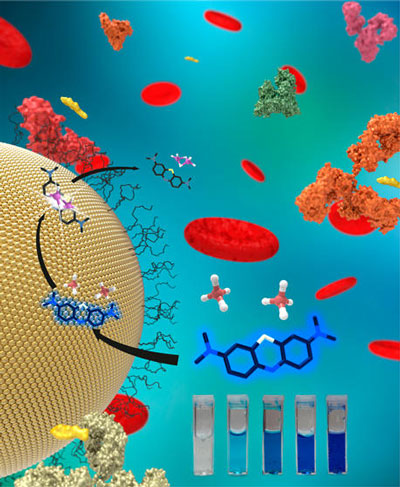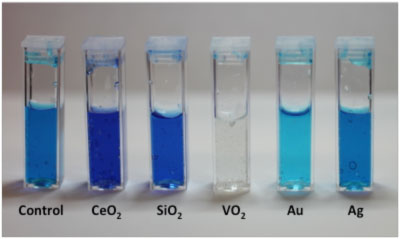| Posted: Feb 20, 2015 | |
A simple test kit for the detection of nanoparticles |
|
| (Nanowerk Spotlight) The use of engineered nanoparticles in commercial products and materials continues at an increasing rate and it appears that no industry can do without them. Nanoparticles are widely added to cosmetics, textiles, catalysts, pharmaceuticals, polishing media, paints, sensors, magnetic fluids, lubricants, foodstuffs, coatings, water treatment and plastics – and that is just a random and incomplete list of applications. | |
| Due to the widespread use of nanoparticles, there is concern from the scientific community regarding the health and environmental impact that nanoparticles may cause. The current lack of knowledge concerning the environmental fate and transport of nanoparticles is partly due to the absence of simple and affordable methodologies for their detection and characterization in complex samples – e.g., waste waters, lakes, oceans, foods, biological fluids, and tissues. | |
| Current analytical methods to detect and characterize nanoparticles require highly trained personnel to operate, expensive instrumentation, time-consuming sample preparation and fixation that may disturb the natural state, and most importantly they do not work well in environmental and biological samples. | |
| Meeting the need for a reliable, sensitive, and accurate methodology for the detection of nanoparticles in complex samples, using low-cost and portable instrumentation, scientists at the University of Washington (UW) now have developed a novel methodology to quickly screen for the presence and reactivity of nanoparticles in commercial, environmental, and biological samples. | |
 |
|
| Schematic of reaction between nanoparticles surface reactivity and colorimetric assay components in complex matrices. (Image: Posner Research Group, University of Washington) | |
| The researchers' ultimate goal is to develop a sensitive, simple, affordable, and portable alternative testing protocol that will determine the surface catalytic activity of nanoparticles, which ultimately screens for nanoparticles in complex matrices. | |
| Reporting their findings in Environmental Science & Technology ("Colorimetric Detection of Catalytic Reactivity of Nanoparticles in Complex Matrices"), a team led by Jonathan D. Posner, Bryan T. McMinn Endowed Associate Professor at UW, the team presents a colorimetric assay – similar to a swimming pool test kit – that tests for the presence or absence of nanoparticles in biological and environmental relevant samples with sufficient sensitivity as part per billion concentration levels. | |
| "Surface reactivity of nanoparticles is a key emerging property related to potential toxicity of materials with living organisms," Posner tells Nanowerk. "We leverage the surface catalytic redox properties of nanoparticles to provide a simple colorimetric detection assay." | |
| He notes that there are three potential applications of this catalytic assay: 1) monitoring known nanoparticles in complex media over time during lab or field studies; 2) industrial hygiene settings where known nanoparticles are being used; and 3) screening for the presence of unknown surface reactive nanomaterials that would be complimented later by more advanced analytical techniques for identification. | |
| In their experiments, the group tests several commercially available nanoparticles and shows that their assay functions in a wide range of complex matrices and does not require elaborate sample preparation, advanced instrumentation or highly trained personnel. | |
 |
|
| Photograph of the colorimetric assay in presence of difference set of metal and oxide nanoparticles. (Image: Posner Research Group, University of Washington) | |
| "We have selected a dye-reductant system that meets several key requirements," explains Charlie Corredor, a Ph.D. graduate research assistant in Posner's group, and first author of the paper. "This system can be detected colorimetrically (dye has different colors in its oxidized and reduced forms); consists of a dye whose reduction is thermodynamically, but not kinetically, favorable; exhibits minimal human toxic effects, materials are not flammable, and stable at room temperature; and is inexpensive for future potential use as a commercially available screening assay for nanoparticles." | |
| The group's future work will focus on the development of a colorimetric assay that will be specific to a nanoparticle's characteristics, like composition, size, concentration, and reactivity. This assay could be integrated into portable devices as well as testing equipment for commercial nanoenabled products during their life cycle. | |
| "We are also interested in correlating nanoparticles' catalytic activity measured with our assay with cellular toxicity assays," concludes Posner. "Overall, this work represents a step toward reliable, sensitive, and accurate methodologies for the detection of nanoparticles in environmental and biological relevant samples, using low-cost and portable instrumentation." | |
 By
Michael
Berger
– Michael is author of three books by the Royal Society of Chemistry:
Nano-Society: Pushing the Boundaries of Technology,
Nanotechnology: The Future is Tiny, and
Nanoengineering: The Skills and Tools Making Technology Invisible
Copyright ©
Nanowerk LLC
By
Michael
Berger
– Michael is author of three books by the Royal Society of Chemistry:
Nano-Society: Pushing the Boundaries of Technology,
Nanotechnology: The Future is Tiny, and
Nanoengineering: The Skills and Tools Making Technology Invisible
Copyright ©
Nanowerk LLC
|
|
|
Become a Spotlight guest author! Join our large and growing group of guest contributors. Have you just published a scientific paper or have other exciting developments to share with the nanotechnology community? Here is how to publish on nanowerk.com. |
|
